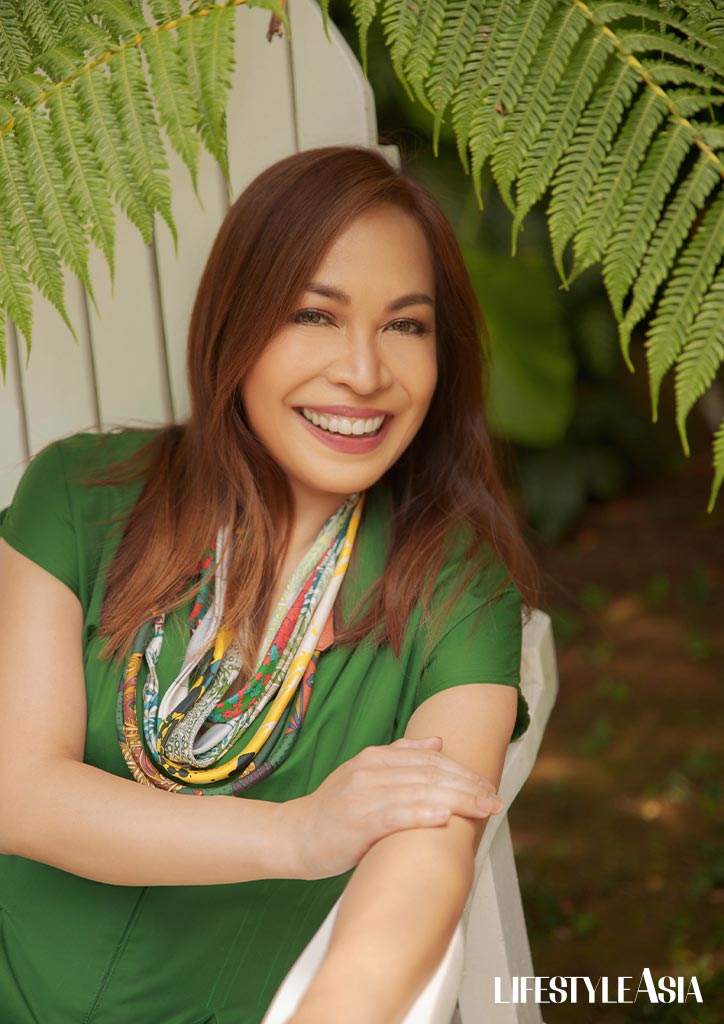The Metro Pacific chief financial officer and chief sustainability officer talks about her experiences with CSR projects and how everyone can join the movement to save the world, our communities, and our loved ones.
“I grew up in a service-oriented environment,” says Metro Pacific Investment Corporation’s Chaye Cabal-Revilla.
Her parents, Jun and Betty Cabal, are government officials in their home province of Leyte. The finance executive fondly remembers how her father would open their doors to people from all walks of life, inviting them over for a meal or two.
“As a kid, I got used to sharing breakfast, lunch, and even dinner with visitors and people that we didn’t know,” she recalls. “In those moments, I learned the mindset that our blessings aren’t for us to keep, but for us to share.”
The multi-awarded finance leader, and 2013 The Outstanding Young Men awardee is on the cover Lifestyle Asia Volume 2, where she shares more stories and lessons on service, leadership, and sustainability. Her beautiful 14-page spread was shot at Antonio’s in Tagaytay, which was recently lauded by Asia’s Best.
Sustainability challenge
Chaye kept her parents’ mind for service intact even as she eventually took on key leadership roles within the PLDT Group of Companies. In her two-decade tenure, the executive sparked a culture of service and volunteerism by starting Gabay Guro in 2007, PLDT’s flagship teacher training, education, and support program.

In 2019, she became PLDT’s chief sustainability officer, launching their environmental stewardship program Gabay Kalikasan during the same year’s National Climate Change Awareness Month.
Chaye admits that pushing for sustainability at work had its unique set of challenges. “Ten years ago, sustainability wasn’t the top priority among my colleagues. It wasn’t required and they viewed it as a nice-to-have. So, we took baby steps and started our sustainability programs on a voluntary basis.”
She recognizes that the unwavering support from their friends and ambassadors like Derek Ramsay and Pops Fernandez and the approval of PLDT chairman and CEO Manuel V. Pangilinan himself were crucial factors in helping sustainability transform into an integral part of the company’s operations.
Pillars of change
Getting more people on board with sustainability, however, also meant dealing with the misconceptions surrounding it.

“A lot of people think that it’s just corporate social responsibility, but in reality, it’s an end-to-end process. If you look at sustainability’s fundamentals, there is what we call a triple bottom line: profit, people, and planet.”
In accounting, the triple bottom line (usually noted as TBL or 3BL) is a framework that measures a company’s value and success via financial, social, and environmental parameters. The chief financial officer helps me understand the concept better by contextualizing it.
“Traditionally, companies would measure their performance and success by the profits that they generate. However, you have to remember that the people—your employees, your customers, and the community at large—make things happen for a company,” she says.
Chaye continues: “So, you ensure that you keep your workers happy and productive. On the other side, you empower communities and clients so that they have enough income and resources to avail your products and services.”
As for the third P, “planet,” Chaye says that we can look at it as remembering that we owe everything to nature, from the air we breathe, the food we eat, and the water we drink.
“If a natural disaster wreaks havoc, your employees will not be able to go to work. Your customers will prioritize saving themselves and getting only what they need at the moment—they may not buy your products or services. Electric posts could topple over, cutting power lines. Waterworks may get destroyed, disrupting water supply,” she elaborates.
Lasting difference
“There won’t be any revenue, and companies handling these utilities would spend a lot to fix the damage,” Chaye adds. Through these examples, she illustrates that since all three Ps are related, you cannot neglect any one of them.
As Cabal-Revilla wraps up her short lesson, she adds a fourth P: purpose.
“When you talk about sustainability and making a lasting difference, you are actually talking about fulfilling your purpose. For instance, why are you operating as a company? And when you relate that with ‘profit,’ you’ll find that there isn’t any conflict at all,” she says.

When a company carries out its purpose, the profit just follows. For instance, Cabal-Revilla explains, MPIC serves the people by providing electricity, keeping our waterworks flowing, ensuring that our tollways are operational, and taking care of communities through our hospitals.
“You get to create programs that increase livelihoods, advocate for environmental causes, among others. It becomes a cycle,” she says.
These principles keep Cabal-Revilla passionate about sustainability even amid numerous challenges.
“When you are convinced that you are in a place where you have a noble purpose and mission, you won’t stop at the first roadblock you encounter. You carry on and try to overcome it,” she says. “I strongly felt that sustainability was something important for all of us to take on. For me, it is both professional and personal.”
The full story on Marion Branellec-De Guzman is in the June 2021 issue of Lifestyle Asia.
Photography SEVEN BARRETTO assisted by ERWIN BOTIN and CLAUDE VILLAHERMOSA
Creative Direction MARC YELLOW
Styling KEITH ANGELO assisted by GILBERT SAMSON
Hair & Makeup JUAN SARTE
Shoot Coordination MAICA TORRES CRUZ
Shot on location ANTONIO’S RESTAURANT





